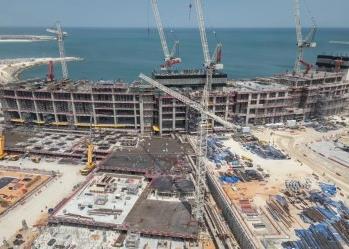
The Gulf emerged as a significant market for project financing in 1994, with rising borrowing levels in Bahrain, Oman, Qatar and Saudi Arabia.
Project loans syndicated among international banks amounted to at least $3,600 million during the year. GCC governments also turned to the market to finance state budgets, with Qatar and Oman raising $1,000 million. In 1993, project lending was considerably lower, with borrowing focusing on sectors such as aircraft finance.
Recent developments include the decision by Saudi Petrochemical Company (Sadaf) to use English law for a $700 million loan to part-finance expansion at its Jubail plant and the coming to syndication in December of three loans arranged by The Sumitomo Bank's London branch for Aluminium Bahrain (Alba), the Manama-based Arab Banking Corporation (ABC) and Qatar (MEED 16:12:94). These are signs that syndicated loan activity in the Gulf is gathering pace, bankers say.
Gulf borrowers came to the market for four categories of loan in 1994: project finance; sovereign borrowing; private capital; and aircraft finance.
Project Finance. Qatar took a lead in raising project finance with four borrowers - Qatar Liquefied Gas Company (Qatargas), Qatar Petrochemical Company (Qapco), Qatar Fertiliser Company (Qafco) and Qatar Shipping Company (Q-Ship) - raising $2,588 million.
Gulf borrowers are turning to project financing techniques common in Asia and Latin America. A recent example is the Omani Manah power plant project which has brought the World Bank's private sector arm, the International Finance Corporation, into the Gulf for the first time (see Oman).
The trend towards using project finance will quicken in 1995 as several major loans come to the market. These include an estimated $3,000 million financing for Qatar's Ras Lafan LNG Company - which can be offered to the market once a sales and purchase agreement is confirmed - and the estimated $6,000 million term loan required to finance the Oman liquefied natural gas scheme.
Sovereign lending to GCC governments increased substantially. Qatar came to the market for $700 million in three loans and Oman borrowed $300 million. Oman also raised $300 million in October 1991, but otherwise GCC governments have used other instruments to boost their balance of payments in the 1990s.
Qatar raised three loans in 1994, including a $250 million facility which came to the market in December, arranged by the London branch of The Sumitomo Bank, Arab Petroleum Investment Corporation (Apicorp), Commerzbank, JP Morgan Securities (JPMS), Qatar National Bank (QNB) and Societe Generale. The New York-based Morgan Guaranty Trust Fund is agent.
Qatar signed a $250 million, five-year term loan on 26 April, arranged by Gulf International Bank (GIB). It also raised a $200 million note purchase facility (NPF), arranged by Chemical Bank.
Private Capital. Syndications recorded in the market in 1994 include a $30 million, five-year term loan for an undisclosed private sector borrower in Qatar, arranged by GIB.
The Bahrain-based Investcorp raised $300 million in May in a three-year facility which attracted 15 banks. Algosaibi Investment Holdings EC raised $62.5 million in a two-year NPF signed on 26 April. The facility was arranged by Lloyds Bank in Dubai.
ABC in Manama launched its first Euroloan to raise $100 million on 2 December. This is expected to be put in place in January.
Aircraft Finance. Gulf Air signed a $134 million term loan in April, arranged by Banque Indosuez, ABC and GIB. There were no other loans in a market which was very active in the early 1990s as Gulf Air and Emirates built up their fleets.
You might also like...

Saudi economy contracts in Q1 2024
07 May 2024

Kuwait plans electric vehicle strategy
07 May 2024

Aramco first quarter profit drops by 14.5%
07 May 2024
A MEED Subscription...
Subscribe or upgrade your current MEED.com package to support your strategic planning with the MENA region’s best source of business information. Proceed to our online shop below to find out more about the features in each package.





